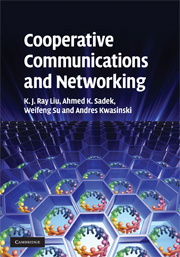Preface
Published online by Cambridge University Press: 06 July 2010
Summary
Wireless communications technologies have seen a remarkably fast evolution in the past two decades. Each new generation of wireless devices has brought notable improvements in terms of communication reliability, data rates, device sizes, battery life, and network connectivity. In addition, the increase homogenization of traffic transports using Internet Protocols is translating into network topologies that are less and less centralized. In recent years, ad-hoc and sensor networks have emerged with many new applications, where a source has to rely on the assistance from other nodes to forward or relay information to a desired destination.
Such a need of cooperation among nodes or users has inspired new thinking and ideas for the design of communications and networking systems by asking whether cooperation can be used to improve system performance. Certainly it means we have to answer what and how performance can be improved by cooperative communications and networking. As a result, a new communication paradigm arose, which had an impact far beyond its original applications to ad-hoc and sensor networks.
First of all, why are cooperative communications in wireless networks possible? Note that the wireless channel is broadcast by nature. Even directional transmission is in fact a kind of broadcast with fewer recipients limited to a certain region. This implies that many nodes or users can “hear” and receive transmissions from a source and can help relay information if needed.
- Type
- Chapter
- Information
- Cooperative Communications and Networking , pp. xi - xivPublisher: Cambridge University PressPrint publication year: 2008



